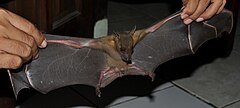Cynopterini
| Cynopterini[1] | |||
| J.E. Gray, 1866[2] | |||
 Przedstawiciel plemienia – krótkonosek indonezyjski (Cynopterus brachyotis) | |||
| Systematyka | |||
| Domena | |||
|---|---|---|---|
| Królestwo | |||
| Typ | |||
| Podtyp | |||
| Gromada | |||
| Podgromada | |||
| Rząd | |||
| Podrząd | |||
| Rodzina | |||
| Podrodzina | |||
| Plemię | Cynopterini | ||
| Typ nomenklatoryczny | |||
Cynopterus F. Cuvier, 1824 | |||
| Synonimy | |||
| Rodzaje | |||
| |||
Cynopterini – plemię ssaków z podrodziny Cynopterinae z rodzinie rudawkowatych (Pteropodidae).
Zasięg występowania
Plemię obejmuje gatunki występujące w południowej i południowo-wschodniej Azji[6].
Podział systematyczny
Do plemienia należą następujące rodzaje[6][7]:
- Megaerops Peters, 1865 – bezogoniec
- Cynopterus F. Cuvier, 1824 – krótkonosek
- Ptenochirus Peters, 1861 – piżmolot
Uwagi
Przypisy
- ↑ Cynopterini, [w:] Integrated Taxonomic Information System [online] (ang.).
- ↑ a b J.E. Gray. A revision of the genera of pteropine bats (Pteropidee), and the descriptions of some apparently undescribed species. „Proceedings of the Zoological Society of London”. 1866, s. 64, 1866. (ang.).
- ↑ K. Andersen: Catalogue of the Chiroptera In the collection of the British Museum. Wyd. 2. Cz. 1: Megachiroptera. London: The Trustees, 1912, s. 88–114. (ang.).
- ↑ a b K.F. Koopman & J.K. Jones: Classification of bats. W: B.H. Slaughter & D.W. Walton (redaktorzy): About bats: A Chiropteran Symposium. Dallas: Southern Methodist University Press, 1970, s. 23. ISBN 978-0-87074-106-7. (ang.).
- ↑ W. Bergmans. Taxonomy and biogeography of African fruit bats (Mammalia, Megachiroptera). 5. The genera Lissonycteris Andersen, 1912, Myonycteris Matschie, 1899 and Megaloglossus Pagenstecher, 1885; general remarks and conclusions; annex: key to all species. „Beaufortia”. 47 (2), s. 69, 1997. (ang.).
- ↑ a b C.J. Burgin, D.E. Wilson, R.A. Mittermeier, A.B. Rylands, T.E. Lacher & W. Sechrest: Illustrated Checklist of the Mammals of the World. Cz. 2: Eulipotyphla to Carnivora. Barcelona: Lynx Edicions, 2020, s. 88. ISBN 978-84-16728-35-0. (ang.).
- ↑ Nazwy zwyczajowe za: W. Cichocki, A. Ważna, J. Cichocki, E. Rajska-Jurgiel, A. Jasiński & W. Bogdanowicz: Polskie nazewnictwo ssaków świata. Warszawa: Muzeum i Instytut Zoologii PAN, 2015. ISBN 978-83-88147-15-9. (pol. • ang.).
Media użyte na tej stronie
Autor: (of code) -xfi-, Licencja: CC BY-SA 3.0
The Wikispecies logo created by Zephram Stark based on a concept design by Jeremykemp.
Autor: Wibowo Djatmiko (Wie146), Licencja: CC BY-SA 3.0
Indonesian Short-nosed Fruit Bat (Cynopterus titthaecheilus), forearm 80mm. From Bogor, West Java.

